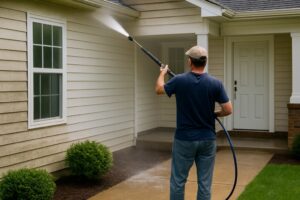Keeping your home in top shape goes beyond just interior cleaning and decor—what people see first is the outside. From the siding and walkways to your deck and driveway, the condition of your home’s exterior plays a huge role in how your property is perceived and preserved. Whether you’re looking to boost curb appeal, protect your investment, or simply enjoy a cleaner, safer space, staying on top of exterior upkeep makes a real difference. This guide explores why clean exteriors matter, how pressure washing works, and what signs to look for when it’s time for a refresh.
Why Clean Exteriors Matter for Every Home
The exterior of your home creates a lasting impression, often shaping how visitors, neighbors, and potential buyers perceive your property. A tidy, well-maintained facade reveals that you take pride in your space and are attentive to its upkeep. Curb appeal does more than satisfy the eye—it can directly affect the value of your property. According to national surveys, homes with regularly cleaned exteriors can sell for up to 7% more than their otherwise identical counterparts. A clean exterior also highlights architectural details and the yard’s landscaping, factors that significantly contribute to a home’s overall appeal.

More than just a cosmetic concern, build-up of dirt, algae, mold, and mildew on your home’s surface can translate to real hazards. These contaminants can break down paint, stain and damage wood or siding, while algae and moss increase slip risks on walkways. Allergens that accumulate on surfaces can exacerbate respiratory conditions in family members with sensitivities. Regular pressure washing, when done correctly or with the help of professionals like A Buff and Beyond, directly addresses both the aesthetics and safety of your home environment, giving peace of mind and a consistently sharp appearance.
By investing in consistent exterior maintenance, homeowners not only protect their property but also extend its lifespan. It’s a small effort that pays off in both comfort and resale value. Ultimately, a clean home exterior reflects the care and attention that make a house truly feel like home.
What Pressure Washing Really Does
Pressure washing utilizes a powerful stream of water, sometimes combined with cleaning solutions, to remove contaminants that accumulate over time. Unlike ordinary garden hoses, pressure washers generate water pressure strong enough to remove grime, moss, mildew, cobwebs, and even persistent stains from a wide range of surfaces—siding, fences, decks, driveways, gutters, you name it. This method isn’t just fast; it also penetrates tiny pores and grooves, ensuring a meticulous clean that traditional scrubbing often can’t match. Pressure washing’s cleaning power means less time spent on ladders or using harsh chemicals, which is why many homeowners make it a part of their routine. For a helpful breakdown of which surfaces can safely be cleaned, Consumer Reports offers a valuable guide to pressure washing various materials without causing damage.
There’s also an environmental angle to consider. With adequate equipment, pressure washing actually uses less water than endless rinsing with a garden hose. Thanks to advances in cleaning technology, biodegradable soaps and efficient pressure settings are now the standard. This means that—contrary to popular belief—pressure washing, when performed responsibly, is one of the greener solutions for maintaining outdoor spaces, reducing runoff of harsh substances, and extending the life of paint and finishes.
Signs Your Home Needs Pressure Washing
- Dark streaks or blotchy stains on siding and gutters typically indicate the growth of mold, mildew, or airborne pollutants.
- The presence of greenish-black algae or moss coating walkways or the northern sides of a home, which thrive in moist and shady conditions, makes the surfaces particularly slippery and hazardous.
- Faded or dull paint indicates dirt buildup has begun to embed into the surface, robbing your exterior of its vibrant color and protective qualities.
Even newer homes can benefit from pressure washing due to persistent exposure to pollen, dust, and fluctuating weather. If you notice spider webs, wasp nests, or simply a grimy feeling under your fingertips when you touch outdoor walls, it’s likely time to schedule a cleaning. In climates with considerable rainfall or pollen, biannual washing can help keep issues at bay and prevent costly repairs down the line.
Step-by-Step: The Pressure Washing Process
Preparing the Area
Before pressure washing begins, clear the workspace of any outdoor furniture, toys, and potted plants. Vehicles should be moved out of the way, and sensitive landscaping covered with plastic sheeting where necessary. Windows and doors should be checked and sealed to prevent leaks.
Selecting the Right Settings
Surfaces vary in strength and porosity, so the pressure and choice of cleaning solution must reflect this. Vinyl siding needs much less pressure than aging brick; wooden decks require gentle sweeping movements to avoid splintering. Many stains can be effectively tackled with mild, biodegradable detergents, while more stubborn buildup may require enzyme-based cleaners. Following manufacturer or professional guidelines keeps your investment safe.
Washing Techniques
Even, methodical strokes are essential for uniform cleaning and to avoid missed spots or streaks. Starting from top to bottom allows debris to flow downward naturally. Always maintain a consistent, appropriate distance from the surface to achieve effective yet gentle cleaning. For intricate details, sometimes hand tools or low-pressure settings are the best options.
Aftercare
Allow surfaces to dry thoroughly before rearranging outdoor furniture or decorations. Inspect areas to address stubborn spots with spot cleaning. Carrying out regular light maintenance—such as sweeping decks or spraying down patios—can help ensure that your freshly washed look endures for many months.
The Visible and Hidden Benefits of Pressure Washing
- Vivid colors and original paint finishes reappear, restoring a like-new appearance that brings renewed pride and stands out on the block.
- Preventative action against rot, decay, and staining extends the structural lifespan of siding, decks, and driveways, helping you avoid expensive repairs.
- Healthier living environments, where mold, mildew, pollen, and algae are thoroughly removed, significantly reduce allergy triggers and harmful bacteria.
Additionally, regularly cleaned driveways and patios are less likely to accumulate slippery algae and moss, ensuring a safer outdoor space for kids and guests to gather.
Conclusion
Ultimately, keeping your home’s exterior clean is about much more than appearances—it’s a smart, protective measure that adds value, ensures safety, and supports a healthier environment. Whether you tackle it yourself or bring in professionals like A Buff and Beyond, regular pressure washing helps preserve your home’s structure, enhances curb appeal, and prevents small problems from becoming costly repairs. By making it part of your ongoing maintenance, you’re not just maintaining a home—you’re investing in its longevity and livability.








